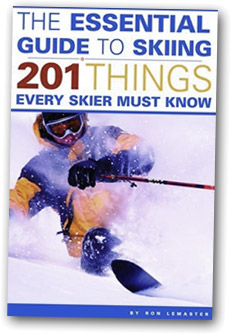
|
|
Ron LeMaster’s book provides a wealth of tips to improve every aspect of your skiing experience.
|
How many things do you know about skiing? In his 259-page book, The Essential Guide to Skiing: 201 Things Every Skier Must Know, Ron LeMaster compiles a list of tips geared towards snowsports enthusiasts. The book provides an excellent entry point for new skiers, but also contains enough revelations to satisfy the most seasoned veteran. Although the book is geared towards skiers, plenty of the tips apply equally well to snowboarders and freeheelers.
Chock-full of illustrations and photos and written in easily digestible sections, The Essential Guide to Skiing touches on major topics including gear and accessories, planning and executing a trip, managing a day on the mountain, and improving ski skills. A native of Boulder, Colorado, LeMaster has been skiing for nearly 50 years. During that time he has served as an instructor, race coach, writer and photographer. The perspective he has gained spills into the book through anecdotes that underscore the various tips he presents.
LeMaster is able to take difficult concepts and distill them into easily-understandable snippits of insight. For example, consider the topic of ski boots. As DCSki Columnist Otto Matheke has argued, no other piece of ski equipment is as important as your boots. LeMaster breaks down the topic into sensible sub-sections that walk through the design and vocabularly of today’s boots, how boots are designed for different fits, how to find the best match between boot and foot, and how to optimize that match through custom upgrades such as Thermo-fit liners, footbeds, and canting. In a sidebar, LeMaster touches on the topic of “soft” boots, a relatively new design of ski boots that attempts to improve comfort by maintaining lateral stiffness while being softer in the front and rear. LeMaster believes this breed of boots will become increasingly popular and is best suited for skiers who spend most of their time on groomed slopes or in soft or junk snow.
Once you’ve found the perfect boot, it’s important to maintain it, and LeMaster suggests buckling your boots up at the end of the season to help preserve their proper shape. Some other tips might seem obvious, such as drying out your boots at the end of a ski day -; but every skier has forgotten to do this at least once. So what’s the best way to dry them out? LeMaster offers several suggestions. In a pinch, you can place boots on top of the refrigerator, where there is warmer, drier air. Don’t use the warm setting on a hair dryer, though, as that can destroy the boots, the hair dryer, or both. LeMaster suggests spending $10 at the local drugstore to purchase a heating pad, placing the boots on top of the heating pad.
LeMaster’s treatment of skis is as extensive as his discussion of boots. Can you name the difference between a “nervous,” “noodly,” or “energetic” ski? LeMaster breaks down ski anatomy and terminology, and also provides a historical perspective on how skis have evolved to their shaped state today.
Determining what to wear to the slopes is a challenge, because weather conditions can change throughout the day. Every skier has learned that the solution is layering, and LeMaster takes a close look at each layer, from the top down and inside out. The tips flow freely on how to optimize your gear; for example, LeMaster approaches the topic of foggy goggles extensively. Did you know that you can purchase a tiny goggle squeegee that attaches to your thumb? “This seems a bit odd at first,” writes LeMaster, “but you quickly realize that it’s perfectly poised to do its job. This is one of those gizmos that’s so simple and effective that it makes you smile when you use it,” he says.
Getting to the slopes can be a chore, and LeMaster breaks down what you should do as a big ski trip approaches. Whether you’re driving on I-70 to Pennsylvania’s Whitetail or I-70 to Colorado’s Copper Mountain, you’ll appreciate LeMaster’s tips about today’s drivetrains and the effect they have on different types of road conditions. LeMaster describes how to recover from oversteer or understeer skids, relaying tips from the Bridgestone Winter Driving School, located in Steamboat Springs, Colorado.
If you’re flying, LeMaster recommends taking your boots as a carry-on item and checking the skis. It’s easier to rent a good pair of skis if yours show up missing; finding a good pair of boots on the slopes is more daunting.
Many books provide tips on skiing, but how about tips on walking around with your skis and ski boots? LeMaster says to forget about all those gizmos ostensibly designed to make it easy to carry skis; he’s never seen a seasoned expert use them. Instead, he shows the tried-and-true technique of hoisting your skis against your shoulder and behind your neck so they’re perfectly balanced.
LeMaster talks about the pros and cons of different lift types. For example, while gondolas are warm, they are typically slower than a standard high-speed chairlift. LeMaster provides a wealth of tips about getting the most out of a ski day, regardless of the snow or weather conditions. On cloudy days that produce flat lighting, he suggests sticking to the side of a tree-lined trail, where the trees block light from hitting the slopes from one side, allowing the snow to cast some shadows.
Do your hands or feet get cold? Here’s a quick tip for warming up your hands in a pinch: swing your arm in a big circle for half a minute. You might look odd doing this, but LeMaster argues that it will force blood into your fingers, warming them up considerably.
When is the best time to take a Ski School lesson? Shoot for the first half of December or mid-January, suggests LeMaster. They are the leanest times of the year for the school, and senior teachers are usually the ones who are assigned the work. During busier times, schools struggle to staff the classes with enough instructors.
LeMaster even provides tips on how to take the best photos on the slopes, avoiding underexposure due to the brightness of the snow, and how to keep your camera happy and functioning despite the cold, snow and humidity.
After reading The Essential Guide to Skiing, you will be anxious to hit the slopes to try out LeMaster’s wide array of tips. There are some real gems in the guide. Some of the tips will confirm your existing hunches while others will be enlightening and only seem obvious in retrospect. The lighthearted book is easy to read and divided into short sections, so you can pick it up anytime and quickly read through a few sections. It is also a guide that will be useful to keep for years; for example, the next time you buy skis or boots, you’ll be reaching for LeMaster’s guide. With a retail price of $21.95, The Essential Guide to Skiing offers a lot of bang for the buck and could be one of the most useful books ever written on the topic of skiing.
The Essential Guide to Skiing is currently available at Amazon.com for $14.93.
M. Scott Smith is the founder and Editor of DCSki. Scott loves outdoor activities such as camping, hiking, kayaking, skiing, and mountain biking. He is an avid photographer and writer.

Join the conversation by logging in.
Don't have an account? Create one here.